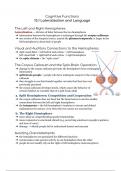Cognitive Functions
13.1 Lateralization and Language
The Left and Right Hemispheres
Lateralization → division of labor between the two hemispheres
➔ information between the hemispheres is exchanges through the corpus callosum
➔ one section of the temporal cortex, named the planum temporale, is larger in the
left hemisphere in about 65% of people
Visual and Auditory Connections to the Hemispheres
➔ right visual field ⇒ left half of each retina ⇒ left hemisphere
left visual field ⇒ right half of each retina ⇒ right hemisphere
➔ the optic chiasm = the “optic cross”
The Corpus Callosum and the Split-Brain Operation
➔ damage to the corpus callosum prevents the hemispheres from exchanging
information
➔ split-brain people = people who have undergone surgery to the corpus
callosum
➔ they struggle to use their hands together on tasks that they have not
previously practiced
➔ the corpus callosum develops slowly, which causes the behavior of
certain children to resemble that of a split-brain adult
a. Split Hemispheres: Competition and Cooperation
➔ the corpus callosum does not heal, but the brain learns to use the smaller
connections between the left and right hemispheres
➔ the interpreter = the left hemisphere’s tendency to invent and defend
explanations for actions, even when the true causes are unconscious
b. The Right Hemisphere
➔ more adept at comprehending spatial relationships
➔ more responsive to emotional stimuli (e.g. perceiving emotions in people’s gestures
and tone of voice)
➔ damage ⇒ oftenly people fail to understand humor and sarcasm
Avoiding Overstatements
➔ the hemispheres are specialized for different functions
➔ certain tasks evoke greater activity in one hemisphere than the other
➔ people do not usually rely on the right or left hemisphere (misconception)






